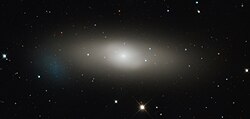Astronomy:NGC 1023
| NGC 1023 | |
|---|---|
 Hubble Space Telescope image of NGC 1023 | |
| Observation data (J2000 epoch) | |
| Constellation | Perseus |
| Right ascension | 02h 40m 24.0s[1] |
| Declination | +39° 03′ 48″[1] |
| Redshift | 0.002125[1] |
| Helio radial velocity | 637 ± 4 km/s[1] |
| Distance | ~19 Mly (Light Travel-Time redshift-based)[1] 30 to 64 Mly (measured)[1] |
| Apparent magnitude (V) | 10.35[1] |
| Absolute magnitude (V) | −21.2[2] |
| Characteristics | |
| Type | SB0[1] |
| Apparent size (V) | 8.7' x 3.0'[1] |
| Other designations | |
| UGC 2154, PGC 10123, MCG+06-06-073, Arp 135 | |
NGC 1023, also known as the Perseus Lenticular Galaxy,[3] is a barred lenticular galaxy, a member of the NGC 1023 group of galaxies in the Local Supercluster. Distance measurements vary from 9.3 to 19.7 million parsecs (30 to 64 million light-years).[1] The supermassive black hole at the core has a mass of (4.4±0.5)×107 M☉.[4] The black hole was discovered by analyzing the dynamics of the galaxy.[5]
NGC 1023 is included in Halton Arp's Atlas of Peculiar Galaxies, under the category "Galaxies with Nearby Fragments" under the number 135.[6]
NGC 1023 has been estimated to have about 490 globular clusters, consistent with similar early-type galaxies.[2] A number of small galaxies have been found around NGC 1023, the collection of which is labelled the "NGC 1023 Group."[7] NGC 1023 has a satellite galaxy named NGC 1023A, which is a Magellanic spiral galaxy; its globular cluster system is much smaller, estimated to be around six individuals.[2]
References
- ↑ 1.00 1.01 1.02 1.03 1.04 1.05 1.06 1.07 1.08 1.09 "NASA/IPAC Extragalactic Database". Results for NGC 1023. http://nedwww.ipac.caltech.edu/cgi-bin/nph-objsearch?objname=NGC+1023&img_stamp=yes&extend=no.
- ↑ 2.0 2.1 2.2 Young, Michael D.; Dowell, Jessica L.; Rhode, Katherine L. (2012). "Globular Cluster Systems of Spiral and S0 Galaxies: Results from WIYN Imaging of NGC 1023, NGC 1055, NGC 7332, and NGC 7339". The Astronomical Journal 144 (4): 103. doi:10.1088/0004-6256/144/4/103. Bibcode: 2012AJ....144..103Y.
- ↑ Stoyan, Ronald; Schurig, Stephan (2014). interstellarum Deep Sky Atlas. Erlangen: Cambridge University Press; Oculum-Verlag GmbH. ISBN 978-1-107-50338-0. OCLC 920437579. http://www.deep-sky-atlas.com/.
- ↑ Graham, Alister W. (November 2008), "Populating the Galaxy Velocity Dispersion - Supermassive Black Hole Mass Diagram: A Catalogue of (Mbh, σ) Values", Publications of the Astronomical Society of Australia 25 (4): 167–175, doi:10.1071/AS08013, Bibcode: 2008PASA...25..167G.
- ↑ Bower, G. A.; Green, R. F.; Bender, R.; Gebhardt, K.; Lauer, T. R.; Magorrian, J.; Richstone, D. O.; Danks, A. et al. (2001-03-20). "Evidence of a Supermassive Black Hole in the Galaxy NGC 1023 from the Nuclear Stellar Dynamics". The Astrophysical Journal 550 (1): 75–86. doi:10.1086/319730. ISSN 0004-637X. Bibcode: 2001ApJ...550...75B.
- ↑ Arp, Halton (1966). Atlas of Peculiar Galaxies. Pasadena, California: California Institute of Technology. http://nedwww.ipac.caltech.edu/level5/Arp/Arp_contents.html. Retrieved 5 Jan 2010. (webpage includes PDF link)
- ↑ Tully, R. B. (1980). "Nearby groups of galaxies. I. The NGC 1023 group.". Astrophysical Journal 237: 390–403. doi:10.1086/157881. Bibcode: 1980ApJ...237..390T.
External links
 |
